-
Paper Information
- Next Paper
- Paper Submission
-
Journal Information
- About This Journal
- Editorial Board
- Current Issue
- Archive
- Author Guidelines
- Contact Us
International Journal of Textile Science
2012; 1(5): 29-35
doi: 10.5923/j.textile.20120105.01
Critical Comparative Analyses of the Display and Interpretation of Two Historical Costume Collections in the United Kingdom
Arwa Khomayyies
Fashion Design, College of Art & Design, King Abdulaziz University, Jeddah-Saudi Arabia
Correspondence to: Arwa Khomayyies , Fashion Design, College of Art & Design, King Abdulaziz University, Jeddah-Saudi Arabia.
| Email: |  |
Copyright © 2012 Scientific & Academic Publishing. All Rights Reserved.
Historical costume and textiles convey cultural meanings and values; a display gets people to see things. Different display techniques allow visitors to engage visually with objects and allow the curator to send certain messages. Therefore the ways in which historical costumes and textiles are displayed reflect a museum’s approach to its collections. The aim of this paper is to analyse and compare the displays of costume collections in two museums in the United Kingdom: Lotherton Hall in Leeds and Bankfield Museum in Halifax. This paper also discusses the difficulties of exhibiting costumes and possible solutions. It also explores the interpretation of textiles and costumes in order to reveal questions of historical value and hidden cultural messages.
Keywords: Museum, Costumes, Interpretation, Textiles, Collection, Display
Cite this paper: Arwa Khomayyies , "Critical Comparative Analyses of the Display and Interpretation of Two Historical Costume Collections in the United Kingdom", International Journal of Textile Science, Vol. 1 No. 5, 2012, pp. 29-35. doi: 10.5923/j.textile.20120105.01.
Article Outline
1. Introduction
- Museums are one of the most important spaces for the preservation and display of cultural artefacts. Although museums contain many types of collection, historical costumes and textiles are well represented and can be used to exhibit items of cultural, historical and artistic significance. Naomi Tarrant has defined ‘costumes’ as ‘all types of clothing whether every day, ceremonial, fancy, folk or theatrical, which have been worn in the past’[1]. There are many ways to present textiles and historical costumes. Museum exhibitions present these objects history as educational aids to inform the public about art, culture, and history[2]. Although museum scholars have long been aware of the power of museum, displays to create compelling narratives about different collections, according to Stephanie Moser, there is a lack of understanding about the extent to which exhibitions create knowledge about the subject they seek to present[3]. Also, as Alexander Palmer points out, there has been a lack of academic and professional training for costume and textile curators[4] that could lead to some poor costume displays in some museums.For centuries, museums stored and preserved collections in an elitist way. Traditional museums have also displayed their historical collections chronologically. The collections are likely to have some objects which are richly documented and other objects that are not. Some artefacts may be in good condition while others may need extensive conservation. The curators select items according to their perceived historical and cultural relevance, to the aim of the exhibition. Textile collections often featured in displays are intended to last a long time and thus influence the way they are interpreted[5].Since the 1970s the museum world has undergone radical change, caused by political and economic pressure. This pressure has forced museums professionals to shift their attention from their collections and to their visitors[6].There has been a noticeable change in museums as a result of this new attempt to control certain aspects of display. This approach has motivated contemporary curators to arrange their collections in ways that appeal to of the visitors. Max Ross claims that “the movement towards a more visitor-centred ethos can be seen as entailing a corresponding shift in the identity of the museum professional, from ‘legislator’ to ‘interpreter’ of cultural meaning”[7]. This idea is compatible with the new museology: people-centred, action- oriented, and devoted to social change and development[8].This emphasizes the correlation between the visitors and the exhibition. Ross suggested that museums must become less exclusive and more responsive to a diverse public and the communities they are supposed to serve. He also asserts that consumers could force museums to consider their needs as they depend on visitor income[9]. Furthermore, Kreps confirms that visitors are a museum’s greatest human resource; therefore traditional methods could be combined with new professional practices to meet the visitors’ needs and to pass on cultural messages[10]. Costume and textile curators in particular need to explore new ways to create attractive exhibitions that explain and expose the many meanings and interpretations of historical costumes and textiles for a modern and sophisticated museum audience[11]. Although costume and textile curators should think about new ways of creating displays, they need to bear in mind the difficulties of working on costume exhibitions. These difficulties are related to the fragility of the historical textiles and how much they may be affected by different factors such as light, heat, and moisture. Curators need to select the way to display these artefacts in that best conveys the intended cultural messages while protecting the objects from deterioration.Sunlight weakens fibres and fades dyes, as do fluctuations in temperature and humidity. Gravity also pulls on and misshapes textiles[12]. Dust and insects also cause serious damage[13]. Palmer theorizes that touch is an important aspect to experiencing textiles and costumes. However he listed this aspect as one of the difficulties because handling might damage textiles. Consequently, curators need to find creative solutions to this problem[14]. According to the importance and difficulties of displaying textiles and historical costumes in museums as an important cultural aspect. It is necessary to consider all factors in the production of exhibitions of textiles and costumes and their effect on visitors’ understanding of them. This paper analyses textile and historical costume displays in two British museums. The paper also compares the textile displays in the two museums in order to investigate how exhibitions draw visitors’ attention and influence their understanding of the objects, both of which could enhance their understanding of history and art. The museums have been chosen because of their significant collections of textiles.
2. Case study
2.1. Lotherton Hall
- Lotherton Hall is the former home of the Gascoigne family who donated it to the City of Leeds in 1968 to be maintained by Leeds City Council. It stands on the eastern edge of the Leeds Metropolitan District and is home to woodland walks, a deer park and a renowned bird garden, house and chapel. The house is surrounded by the usual gardens and spaces we have come to expect in eighteenth- and nineteenth-century estates. The rooms and furnishings are also related to the eighteenth and nineteenth. However, there is no public transport to Lotherton Hall, so this limits the number of visitors. According to Leeds Museums and Galleries, Lotherton is one of the few museums in the North of England which has undertaken the ambitious task of collecting and displaying costumes. The collections include some undergarments and accessories, such as shoes, bags, hats, fans and gloves, from the seventeenth century onwards. Some of the clothes in the collection are so fragile that they can be kept on view only for a limited time[15].Some curtains, bed sheets, chairs and rugs are original to the house. Some of these them are still in a good condition but others have frayed or faded. However there has been some recent conservation work to preserve the fragile textiles. The situation in Lotherton Hall actually contradicts Tarrant’s assertion that most house owners are less aware of the importance of their textile collections than they are of its paint and furniture[16]. The textile and costume display at Lotherton Hall between 2nd of March and 31st December-2010 was about feathers as a part of the (Flock Together Bird) –inspired exhibitions and events across Leeds in 2010 showed how birds have influenced fashion since the 19th century. Lotherton Hall charges admission. Reliance on visitor income, as Ross maintains, forces museums to remain sensitive to public preference, taste, and demand[17].
2.2. Bankfield Museum
- For half a century Bankfield was the principal home of one of Halifax’s foremost woollen manufacturers: Edward Akroyd. The first phase of Bankfield’s development took place between 1815 and 1838. In 1887 Bankfield was sold to Halifax Corporation. Shortly thereafter it was converted it to a Museum and Branch Library[18]. The location of the museum means that it is easy to access and the entrance to the house still reflects the architecture of the nineteenth century. The internal organization of the museum has completely changed so that it does not emphasize or reflect any cultural theme or era since the house was sold without its furnishings. The first floor in the museum now contains the Costume and Textile Gallery; the main floor houses galleries such as the World of Textile Gallery and temporary exhibition gallery. As of this writing, Calderdale Council is running a project, funded by the Heritage Lottery Fund, using Calderdale museums’ collections to explore the heritage of different cultural traditions to inspire and spark creativity. The title of the project is ‘Making it in Calderale’ and the slogan is ‘Bringing People Together’. The exhibition ran from 15 May to 27 June 2010 at Bankfield Museum and the exhibition concentrated on the costume and textile collections and projects. There is also an exhibition at Bankfield of new work by the 10+Textiles group using fine hand and machine embroidery, weaving, patchwork, quilting and mixed media. The group members all have their own styles and the result is a fusion of traditional techniques with modern design. Admission is free at Bankfield Museum, with a large number of local Council Museums. As Ross argues, when a museum is not dependent on admission fees, it has more freedom to appeal to a minority rather than considering public preferences[19]. This seems to be true from my observations. Although the objects of the 10+textiles exhibition are for sale, they appeal to the minority who are interested in textile art. In general, although the two museums house different collections they share an interest in textile and costume collections and exhibitions. However, this paper will compare one section the main textile attraction and costume exhibition of the two museums: the Flock Together Bird costume and textiles inspired Exhibitions in Lotherton Hall, and the Costume and Textile Gallery in Bankfield Museum. This comparison will be based on the main criteria in displaying textiles and costumes in museums. Most of the information was collected from direct observation of the two museums.
2.3. Type of collections and Display
- The objects in Lotherton Hall are displayed thematically. This theme is birds and feathers, the inspiration for the design of many costumes, textiles and accessories in the nineteenth and twentieth centuries. These objects are displayed in a temporary exhibition on the second floor of the house and divided into the following groups:• Dresses, masks, hats, fans, caps and muffs from the eighteenth and nineteenth centuries, all of which were designed and made using feathers. • Dresses and textiles which were woven, printed or embroidered using a bird feather symbol. There is a school blazer with an embroidered owl and a textile from the 19th century printed with a peacock and other birds. • Accessories such as silver bracelets, brooches and hair combs from 1870 to 1950, are shaped like birds and feathers.• Textiles made for insulation and stuffed with feathers such as the Summit Suit (2009),the underskirt of a petticoat (1870-1880) to keep the legs warm and to create a full- skirted look, and a bed cover (1920-1950). In Bankfield Museum, the Costume and Textiles from around the World exhibition is part of the permanent display on the first floor. The front gallery includes a selection of clothing and textiles from Asia, Africa, Eastern Europe and Australia. The back gallery traces the changing shape of women’s fashion in England from 1825 to 1925. According to the Bankfield Museum, these collections were collected by Henry Ling Roth, the first curator of Halifax museum. He was especially interested in collecting textiles and began to build this collection over the years. Lotherton Hall has adopted a new approach to displays which follows Palmer’s ideas about the concept of exhibiting costume and textiles in museums by arranging the collections by theme[20]. This approach helps the curators to emphasise certain messages by using different displays under one theme while the traditional costume display, as Palmer said, always follows a chronological order to emphasise change[21]. The costume exhibition at Bankfield uses a traditional chronological approach that emphasises the changes in appearance according to the time rather than focusing on certain features in the artifacts.
2.4. Space
- Space is a fundamental element of display and as Stephan Moser explains, space is more than a matter of physical parameters. It includes a consideration of the way visitors move and the exhibition layout 22 Accordingly, collections at Lotherton Hall are housed in a special space on the second floor which is the last room one visits on the house tour. This space is divided into corridors and rooms. A special entrance leads to the exhibition. In this entrance there is a big stand which contains the Logo and the name of the exhibition. After the visitors pass this small entrance, there is a long corridor with fashion plates on both walls which emphasize and reflect the theme of the exhibition. This setting prepares visitors to expect a different exhibition and display from what they already have seen around the house. However, visitors cannot see the entirety of the displays at a glance as the objects are obscured because the display is created in a space that already exists, and the nature and character of this space affects both the selection of the material and the way it is displayed. The objects are displayed in groups with sufficient spaces between them, such as hats with feathers in a glass case, accessories which are decorated with a bird symbol on special shelves. It seems easy to walk through the rooms which guide the visitors from the entrance to the end of the exhibition. This layout confirms Moser’s observation that displaying in small rooms creates a more intimate feeling and a more private way of engaging visitors in the theme of the exhibition[23]. The collection in Bankfield Museum is housed on the first floor which is divided into spaces and cases. As visitors access the exhibition area they have to climb the main stairway in the house. However, the walls seem to need renovation, and the rugs hanging on them are in need of restoration. The stairs lead to the exhibition entrance through a gloomy and rather unwelcoming corridor.Although the exhibition space is part of the house, it has been rebuilt and designed for the costume and textiles exhibitions. The collections are divided into groups according to the countries and cultures such as Africa, Palestine, France and England, each of which is displayed in a private space surrounded by glass cases except the English costumes which are displayed in the largest space at the back of the gallery. This emphasizes the importance of the British costumes collections in Bankfield Museum. As a point of comparison with Lotherton Hall, visitors can wander freely around the gallery. The space does not enhance the experience of the exhibition message.
2.5. Design
- The design scheme can reinforce the exhibition’s message. As Moser confirms, the “look” or design quality of the galleries and rooms is a critical factor in display analysis.[24]According to this, the design scheme in the feather exhibition of Lotherton Hall does not emphasise the historical aspect because it is not an essential message of the exhibition which asserts the way of birds and their feathers chare inspired the textiles and fashion during the last two centuries, while other textiles are part of the rooms’ design.
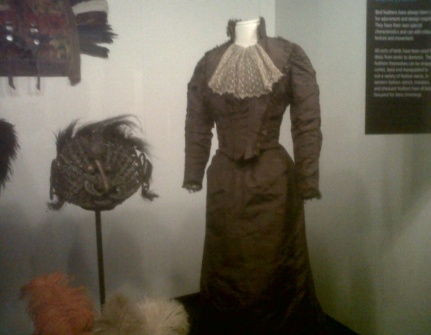 | Figure 1. A dress at Lotherton Hall exhibition decorated by using feathers in the sleeves, and other related objects which were used as a decoration |
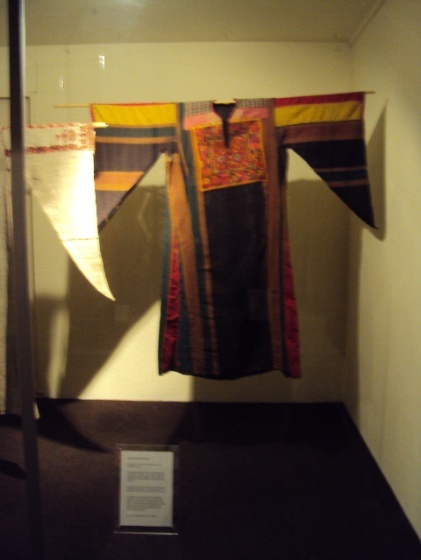 | Figure 2. Palestinian costume in Bankfield Museum illustrated in a plain space without any decoration or background |
2.7. Colour and Light
- Colour can endow the exhibition with symbolic significance and convey a mood that might enhance or contradict the message of an exhibition[25].In Lotherton Hall the walls are painted in matte green with brown fabric edges and the floor is covered with a black carpet. All backgrounds are white and the display cabinets are brown. The lighting system is based on artificial spotlights which are distributed among the objects and offer a clear view of the objects in detail, to guide visitors and to enable them to read texts. There is no natural light; all the windows are covered with blackout curtains for conservation purposes.The colours in the Bankfield exhibition range from warm to cold. There is a blue ceiling, green walls and varied colours in each room. All these colours come in strong dark shades. The lighting system is similar to that found in Lotherton Hall, it uses spotlights, but the lights in Bankfield are not bright enough to direct visitors’ attention to the objects. Sunlight is also blocked in Bankfield by thick curtains and barriers. The curators in both museums are aware of the deleterious effects of light on textiles.
2.6. Display Method
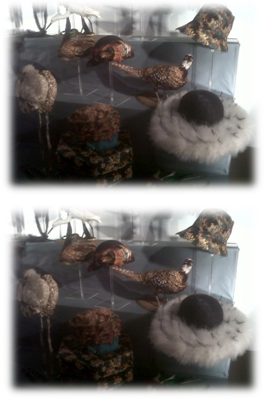 | Figure 3. Hats on Perspex stands at Lotherton Hall |
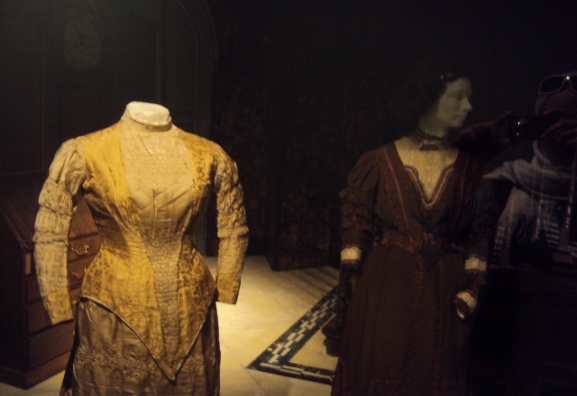 | Figure.4. Displaying costumes by using dummies at Bankfield Museum |
2.8. Labels and Texts
- The message of any exhibition and how it is presented in textual accompaniments to the displays needs to be considered in museum display analysis[27].In Lotherton Hall, the texts are written on white A4 size paper in black ink. The labels are not numbered but there is a photo of each object accompanied by the object’s name, essential information, and its connection to the main purpose of the exhibition. The labels are put in front of each window with certain groups of objects. This method makes it easier for visitors to read the information. It also makes a memorable visual impression on visitors. In the entrance of each room or section a large blackboard which is hung on the wall and presents historical and scientific information and photos with references about the exhibition and birds (figure 5). Two TV screens present two short clips; the first one presents photos for people who are wearing costumes with a feather and bird influence. The second explains the idea behind this project with interviews with the textiles curators responsible for this exhibition.
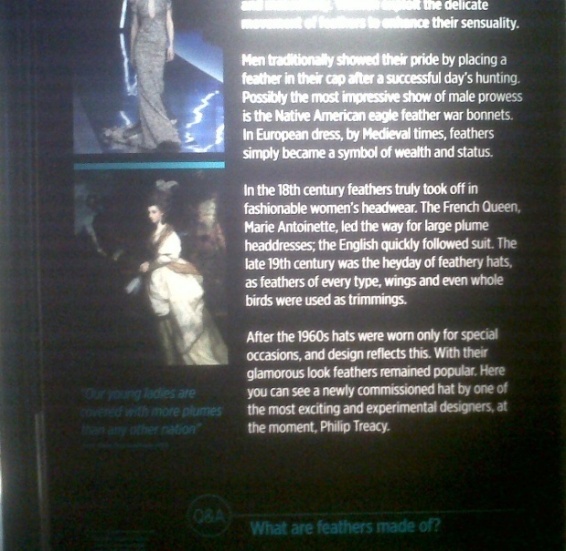 | Figure 5. A blackboard at Lotherton Hall illustrates relevant information and photos |
3. Conclusions
- To sum up, the Lotherton Hall exhibition has adopted new approaches to the display of historical costumes and textiles by linking the collection to a certain theme and illustrating information by using special text styling, graphic designing, and concentrating on different display details. This helps to convey the main message of the exhibition to visitors: is the correlation of birds and feathers to textiles and costumes during the nineteenth and twentieth centuries. This also includes appreciation of the different aspects of art, design and historical use of textiles and materials. At the same time, according to the methodological framework which has been used in this paper, the display at Bankfield Museum is based on a traditional exhibition which depends on storing and preserving objects without using them to convey clear messages to visitors or to impart real knowledge. This point leads to the importance of reusing the old objects to create new and contemporary interpretations which definitely adds more value to the textiles and historical costumes and makes them more vivid, more memorable, more lasting, and draws public and specialist attention to these artifacts as rich and essential elements of any national culture. Further studies and projects, which focus on the artistic, manufacturing, historical and cultural aspects of traditional and historical costume, could be done if curators become more aware of the quality within their textile exhibitions and if museums shift their emphasis from quantity to quality. In general, “it is always the museum which guides the games and sets the rules; the public can move intellectually, but always within the limits imposed by the museum”[28]. The data presented in this paper are based on observations of visitors’ experience in these two museums. Political and funding considerations that could affect the display approach are beyond the scope of this paper. However, application of the new museology theory is recommended in order to facilitate successful exhibitions of textiles and costumes and to involve researchers, collectors, curators, specialists, and the public in such projects.
Notes
- 1. Naomi Tarrant, Collection Costume the Care and Display of Clothes and Accessories (London: George Allen & Unwin, 1983), p.1. 2. Stephanie Moser, ‘ The Devil is in the Detail: Museum Displays and the creation of Knowledge’, Museum Anthropology, 33 (2010), 22-32 (p.22)3. Moser, p.22.4. Alexander Palmer, ‘Untouchable: Creating Desire and Knowledge in Museum Costume and Textile Exhibitions’, Fashion Theory, 12(2008), 31-64 (p.31)5. Palmer, p.35. 6. Max Ross, ‘Interpreting the new Museology’, Museum and Society, 2 (2004), 84-103 (p.84).7. Ross, p.84.8. Christina Kreps , ‘Appropriate Museology in theory and practice’, Museum Management and Curatorship,23 (2008),23-41 (p.28).9. Ross.p.100.10. Kreps, p.39.11. Palmer, p.59.12. Palmer, p.36. 13. Sheila Landi, The Textile Conservator’s Manual (Oxford: Butterworth Heinemann,1999),p.170. 14. Palmer, p.3215.Leeds Museums and Galleries, Lotherton Hall (Leeds: Leeds city Council,2007), pp.2-4,4216. Tarrant, P.132.17. Ross, p.87.18. Calderdale Council, B19. Ross, p.86.20. Palmer, p.50.22. Palmer, p.35.23. Moser, p.24.24. Moser, p.25.25. Moser, p.26.26. Landi, p.162.27. Moser, p.26. 28. Palmer, p.35.
 Abstract
Abstract Reference
Reference Full-Text PDF
Full-Text PDF Full-Text HTML
Full-Text HTML